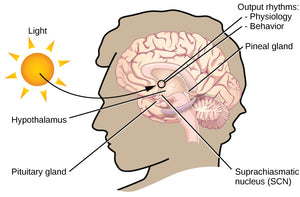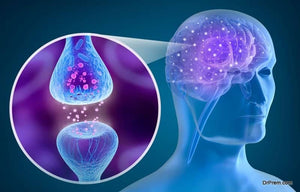Neurons and synaptic transmission
Neurons and How They Work: A Guide for Students
When we talk about our thoughts and mental processes, we're actually talking about the activities happening in our nervous system, particularly the brain. The brain is primarily composed of glial cells and astrocytes, but the real heroes of the show are the neurons. These are specialised cells that carry electrical impulses to and from the central nervous system.
In fact, the average human brain contains around 100 billion neurons, and each neuron is connected to about 1,000 other neurons. This intricate network of connections forms complex neural networks, which are responsible for the brain's incredible processing power.
The Journey of an Electrical Signal: Action Potential
Neurons have the important job of transmitting information within themselves and from one neuron to the next. It all starts with the dendrites, which receive information from sensory receptors or other neurons. This information is then passed down to the cell body and eventually to the axon. Once the information reaches the axon, it travels down its length as an electrical signal called an action potential.
Understanding Neurons: Structure and Function
Neurons are specialised cells designed to carry neural information throughout the body.
There are three types of neurons: sensory neurons, relay neurons, and motor neurons.
A typical neuron consists of a cell body, dendrites, and an axon. The dendrites receive signals from other neurons or sensory receptors and transmit them to the cell body, which acts as the control centre of the neuron. From there, the impulse travels along the axon until it reaches the axon terminal. In many nerves, such as those in the brain and spinal cord, the axon is surrounded by an insulating layer called the myelin sheath. This allows nerve impulses to travel rapidly along the axon. If the myelin sheath is damaged, the impulses slow down. Neurons can vary in length from a few millimetres to up to one metre.

Sensory Neurons: Receiving Information
Sensory neurons play a crucial role in carrying nerve impulses from sensory receptors (such as those for vision, taste, and touch) to the spinal cord and the brain. Sensory receptors are located in different parts of the body, like the eyes, ears, tongue, and skin.
When these receptors detect stimuli, sensory neurons convert the information into neural impulses. These impulses then reach the brain, where they are translated into sensations like visual input, heat, pain, and more. Not all sensory information needs to reach the brain, though. Some neurons terminate in the spinal cord, allowing for quick reflex actions without the delay of sending impulses to the brain.
Relay Neurons: Communication between Neurons
Most neurons fall between sensory and motor neurons, acting as intermediaries between the input and output of the nervous system. These neurons are called relay neurons or interneurons and reside entirely within the brain and spinal cord. They allow sensory and motor neurons to communicate with each other, ensuring smooth information flow.
Motor Neurons: Controlling Muscles
Motor neurons are responsible for conducting signals from the central nervous system (CNS) to muscles and other effector organs. While their cell bodies are located in the CNS, they have long axons that extend into the peripheral nervous system (PNS). Motor neurons form synapses with muscles and control their contractions. When a motor neuron is stimulated, it releases neurotransmitters that bind to receptors on the muscle, triggering a response that leads to muscle movement. The strength of muscle contraction depends on the rate of firing of the axons of motor neurons that control it. Relaxation, on the other hand, occurs when the motor neuron is inhibited.
Synaptic Transmission: Passing the Baton
Once an action potential reaches the end of an axon, known as the terminal button, it needs to be transferred to another neuron or tissue. To accomplish this, it must cross a gap called the synapse, which consists of the end of the presynaptic neuron, the postsynaptic neuron's membrane, and the gap in between. At the end of the axon, there are sacs called synaptic vesicles that contain chemical messengers called neurotransmitters. When the action potential reaches the synaptic vesicles, they release their contents through a process called exocytosis.

The released neurotransmitters diffuse across the synaptic gap and bind to specialised receptors on the postsynaptic cell's surface. These receptors recognise and are activated by specific neurotransmitters. Once activated, the receptor molecules produce either excitatory or inhibitory effects on the postsynaptic neuron.
The whole process of synaptic transmission occurs in a fraction of a second and is usually terminated by a process called reuptake. The presynaptic neuron takes back the neurotransmitter from the synaptic cleft, storing it for later release. The speed at which this reuptake occurs determines the duration of the neurotransmitter's effects. Some antidepressant drugs inhibit this reuptake process, prolonging the presence of neurotransmitters in the synapse. Additionally, enzymes produced by the body can deactivate neurotransmitters that have stimulated the postsynaptic neuron.
Excitatory and Inhibitory Neurotransmitters: Turning Things On and Off
Neurotransmitters act as chemical messengers, carrying signals across the synaptic gap to the receptor sites on the postsynaptic cell. These neurotransmitters can be classified as either excitatory or inhibitory in their action. Excitatory neurotransmitters, like acetylcholine and noradrenaline, increase the likelihood of an excitatory signal being sent to the postsynaptic cell, making it more likely to fire. Inhibitory neurotransmitters, such as serotonin and GABA, decrease the likelihood of the neuron firing. Inhibitory neurotransmitters generally help calm the mind and body, induce sleep, and filter out unnecessary excitatory signals.
When an excitatory neurotransmitter binds to a postsynaptic receptor, it causes an electrical change in the membrane of the cell, resulting in an excitatory postsynaptic potential (EPSP). This makes it more likely for the postsynaptic cell to fire. Conversely, when an inhibitory neurotransmitter binds to a postsynaptic receptor, it leads to an inhibitory postsynaptic potential (IPSP), making it less likely for the cell to fire.

A nerve cell can receive both EPSPs and IPSPs simultaneously. The likelihood of the cell firing is determined by adding up the excitatory and inhibitory synaptic inputs. This calculation, known as summation, ultimately determines whether or not the cell will fire. The strength of an EPSP can be increased through spatial summation, where multiple EPSPs are generated at different synapses on the same postsynaptic neuron simultaneously. In temporal summation, a series of high-frequency action potentials on the presynaptic neuron generate multiple EPSPs at the same synapse. The firing rate of a specific cell is influenced by the activity of its synapses. If excitatory synapses are more active, the cell fires at a higher rate. Conversely, if inhibitory synapses are more active, the cell fires at a lower rate or not at all.
Now that you have a better understanding of neurons and synaptic transmission, it's time to put your knowledge to the test! Take our interactive quiz to assess how well you've grasped the concepts we've covered. The quiz will challenge you with questions about neuron types, synaptic transmission, and the role of neurotransmitters. It's a fun way to reinforce what you've learned and identify areas that may need further exploration.
Remember, learning is an ongoing process, and quizzes like these can help you gauge your progress. Don't worry if you don't get all the answers right. Use it as an opportunity to delve deeper into the topics that interest you. By building a solid foundation of understanding, you'll be better equipped to explore the fascinating world of neuroscience and its applications in various fields.
So, are you ready to take the quiz? Click on the link below and show off your neuron knowledge!




